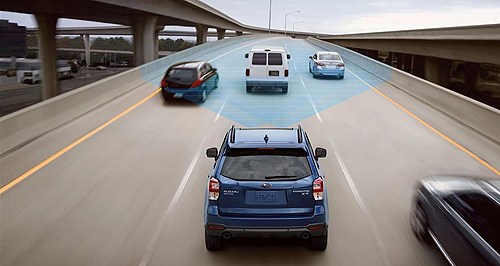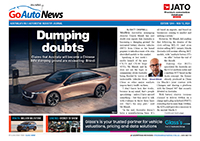Make / Model Search
News - SubaruSubaru’s next-gen EyeSight detailedEye see you: Subaru has upgraded its EyeSight technology, now in its third-generation, with colour recognising front-facing stereoscopic cameras. Auto lane changing on the horizon, but Subaru not committed to fully autonomous14 Apr 2017 By TUNG NGUYEN in JAPAN SUBARU is incorporating more self-driving technologies into its EyeSight driver assistance safety suite, but the brand is adamant it will not bring a fully autonomous vehicle to market in the near future. Speaking to GoAuto, Subaru general manager of overseas sales and marketing Makoto Inoue said EyeSight will be used to compliment some driving situations, but the Japanese car-maker is committed to producing vehicles that engage drivers. “Our intention is to provide the driving pleasure to the customer, if you look at say… the current autonomous driving, some of the manufacturers are going to introduce completely autonomous driving, but our intention is not like this,” he said. “Definitely we would like to give the right pleasure to the drivers, even though a lot of the driver assist systems will be available, we have no intention to make a completely autonomous driver in the current product.” Currently, Subaru’s EyeSight safety system is in its third iteration and utilises a pair of forward facing cameras to monitor traffic and obstacles ahead, and is available across models including the new Impreza, Forester, Outback, Levorg and incoming XV. The current-generation system allows vehicles access to safety technologies including adaptive cruise control, lane keep assist and pre-collision braking and throttle management, with a current Australian adoption rate of about 60 per cent of all new Subarus sold. With the release of the new-generation XV crossover, that figure is expected to rise to 70 per cent by year’s end. However, while Subaru has no intention of adopting fully self-driving cars, Mr Inoue revealed new versions of EyeSight, which will include semi-autonomous modes, are designed to assist the driver, not to take control away from them. “In the near future, we are going to introduce EyeSight with the function of automated lane changing system and also in the highways, in the traffic jams, let’s say autonomous driving, those kinds of things we are going to introduce,” he said. “We have to consider to enhance the stereo camera systems capabilities first, and then… maybe we also have to consider fusion mixing with stereo camera and some sensors. “My answer is we definitely we have to consider to provide kind of autonomous driving, in order to reduce driver fatigue while long driving or something like that, but completely autonomous is not our intention.” Mr Inoue also revealed that Subaru is currently exploring technologies that will allow for vehicle-to-vehicle and vehicle-to-infrastructure communications allowing its vehicles to interact with future fully autonomous transportation. Subaru Australia national corporate affairs manager David Rowley added that technology was being developed that would allow EyeSight to recognise speed limits and traffic lights. When asked if the technologies developed would take away from the driving experience – something Subaru said it is prioritising – Mr Rowley said: “We think quite the contrary, we think it actually gives people a level of insurance so that they can drive to the full extent of their own capabilities yet at the back of their mind have that peace of mind that the car can intervene if necessary.”  Read more22nd of December 2016  Driven: Subaru Impreza sales set to multiplyBig Impreza improvements, and extended service could double sales: Subaru8th of July 2016  Subaru puts safety firstAll-wheel-drive and EyeSight technology key to differentiating Subaru27th of June 2016  Personality key to attracting new buyers to SubaruNew Subaru branding targets fresh buyers as new Impreza launch looms |
Click to shareSubaru articlesResearch Subaru Motor industry news |











Facebook Twitter Instagram